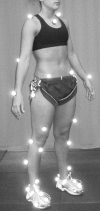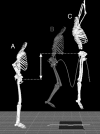Biomechanical and performance differences between female soccer athletes in National Collegiate Athletic Association Divisions I and III
- PMID: 18174935
- PMCID: PMC2140072
Biomechanical and performance differences between female soccer athletes in National Collegiate Athletic Association Divisions I and III
Abstract
Context: The recent increase in women's varsity soccer participation has been accompanied by a lower extremity injury rate that is 2 to 6 times that of their male counterparts.
Objective: To define the differences between lower extremity biomechanics (knee abduction and knee flexion measures) and performance (maximal vertical jump height) between National Collegiate Athletic Association Division I and III female soccer athletes during a drop vertical jump.
Design: Mixed 2 x 2 design.
Setting: Research laboratory.
Patients or other participants: Thirty-four female collegiate soccer players (Division I: n = 19; Division III: n = 15) participated in the study. The groups were similar in height and mass.
Intervention(s): Each subject performed a maximal vertical jump, followed by 3 drop vertical jumps.
Main outcome measure(s): Kinematics (knee abduction and flexion angles) and kinetics (knee abduction and flexion moments) were measured with a motion analysis system and 2 force platforms during the drop vertical jumps.
Results: Knee abduction angular range of motion and knee abduction external moments were not different between groups (P > .05). However, Division I athletes demonstrated decreased knee flexion range of motion (P = .038) and greater peak external knee flexion moment (P = .009) compared with Division III athletes. Division I athletes demonstrated increased vertical jump height compared with Division III (P = .008).
Conclusions: Division I athletes demonstrated different sagittal-plane mechanics than Division III athletes, which may facilitate improved performance. The similarities in anterior cruciate ligament injury risk factors (knee abduction torques and angles) may correlate with the consistent incidence of anterior cruciate ligament injury across divisions.
Keywords: knee flexion angle; knee valgus; lower extremity; women's soccer.
Figures





References
-
- National Collegiate Athletic Association. NCAA Injury Surveillance System (ISS) Sport Specific Injury Data. Indianapolis, IN: National Collegiate Athletic Association; 2003.
-
- Schmidt-Olsen S, Jorgensen U, Kaalund S, Sorensen J. Injuries among young soccer players. Am J Sports Med. 1991;19:273–275. - PubMed
-
- Nilsson S, Roaas A. Soccer injuries in adolescents. Am J Sports Med. 1978;6:358–361. - PubMed
-
- Ostenberg A, Roos H. Injury risk factors in female European football: a prospective study of 123 players during one season. Scand J Med Sci Sports. 2000;10:279–285. - PubMed
-
- Griffin LY, Agel J, Albohm MJ. Noncontact anterior cruciate ligament injuries: risk factors and prevention strategies. J Am Acad Orthop Surg. 2000;8:141–150. et al. - PubMed
Publication types
MeSH terms
Grants and funding
LinkOut - more resources
Full Text Sources
